Early libraries and reading rooms in the territory of Russia and the Commonwealth of Independent States centered mainly around churches and monasteries. From the 15th to 17th centuries, libraries began to appear in Moscow. Peter the Great established the first libraries of secular and scientific character in the 18th century. The first public library appeared in Russia with the establishment of the Imperial Public Library, now the Russian National Library, in St Petersburg on May 27, 1795 by Catherine the Great. The number of university libraries began to increase around the first half of the 19th century. By the late 19th and early 20th centuries, the concept of librarianship in Russia really started to spread as did public libraries. In 1908, the Society for Librarianship was founded. By 1914, there were close to 80,000 libraries.
There were a number of very important journals on book matters, bibliography, and library science in the 18th and 19th centuries. Among those were Drevniaia rossiiskaia bibliofika (1773-1775, 1776), Bibliograficheskie izvestiia (1846), Bibliograficheskie zapiski (1858-1859, 1861), Knizhnik (1865-1866), Bibliograf (1885, first one was published in Dek. 1884,-1914), Knigovedenie (1894-97), and Vestnik knigoprodavtsev (1900-1905).
Drevniaia rossiiskaia bibliofika and Bibliograf were especially important. The goal of Drevniaia rossiiskaia bibliofika was to facilitate the study of Russian culture and history and to preserve what the editors considered to be their important facets. Catherine the Great supported the journal and gave the editors the right to use the State archives. In 1788, the editor, N. Novikov, republished Drevniaia rossiiskaia bibliofika under a slightly different title (the subtitle changed), expanded it, and included publications up until the times of Peter the Great. Bibliograf played a huge role in the development of bibliographical periodicals and in the collecting of statistics on printed materials. Bibliograf contained catalogs of new books in Russian and foreign languages and also indexes of articles in periodical publications. For several years, the editor of Bibliograf put together lists of Russian periodical publications beginning with the publication of Vedomostei of 1702. On the basis of these lists, M. M. Lisovskii prepared his famous Bibliografaia russkaia peroidicheskaia pechat.
After the 1917 revolution, the development of libraries across the country took on great importance as the government tried to educate the people and eradicate illiteracy. Professional library education also spread as the development of libraries grew and institutes of culture opened throughout Russia. The period after World War II saw the organization of libraries in various republics and in rural areas of Russia. Despite political constraints, literacy, book publishing, and libraries continued to be extremely important during Soviet times.
After the fall of the Soviet Union, it was a time of great excitement as people were given access to information that they had never known before. Information needs were also changing all over the world as the Internet took on more importance in the everyday lives of people. Since that time, Russian libraries and librarians have had to deal with many political and economic transitions that have affected every facet of Russian librarianship. Despite that, the Russian library system still remains a vital institution today.
Bibliographies
The following bibliographies have been published by Gosudarstevennaia biblioteka SSSR imeni V. I. Lenina.(Lenin Library-State Library). As you will see, they have undergone several name changes, changes in publication patterns, and content such as author and title inclusion.
Bibliografiia Bibliotekovedeniia; Annotirovannyi Ukazatel.
Issued by Nauchno-metodicheskii cabinet bibliotekovedeniia of Gos. Biblioteka SSSR. V.I. Lenina. Moscow. 1935-57.
OCLC: 621252028
Bibliografiia Bibliotekovedeniia; Annotirovannyi Ukazatel presented new literature on the questions of library science and bibliography and was aimed at teachers and students at library institutes. Publications cited include textbooks, other pedagogical materials, publications of libraries and library schools, periodicals and sborniki articles, and the more significant newspaper articles. Citations represented those materials published in the former Soviet Union in both the Russian language and other languages of the former Soviet Union. Also included in the bibliography were publications from Western European countries in the Communist Bloc at that time. Although not comprehensive, the bibliography is quite extensive.
It is divided into two parts: Soviet literature and literature of the countries of the Communist Bloc. Topics in the first part are given in the following order: any material regarding the Communist party; larger libraries of the Soviet Union; library matters of the Soviet Union; military libraries and other specialized libraries such as those involving children, etc.; training and teaching of librarians; history of libraries and librarianship in the Soviet Union; content, organization, and method of working with readers; libraries fonds and catalogs; and other matters such as norms, private libraries, reviews, bibliographic work of librarians, etc.
Besides “Annotirovannyi Ukazatel,” another subtitle one may see is “informatsionnye materialy.” The publication pattern also varies: monthly, 1935 to 1940; 10 issues in 1941; 2 issues in 1942; quarterly in 1943; 6 issues in 1944; 5 issues in 1945; and quarterly from 1946 to 1957. The researcher should be aware that sometimes the year on the cover reflects publication date and not coverage date. For example, the issue for 1956:4 has 1957 on the front cover since that is the year in which it was published; however, on the inside title page, it indicates that it is issue No. 4 for Oct. to Dec., 1956. Also, issue 1947:4 came out in 1948, and issues 1948:1-4 came out in 1949.
An extensive table of contents is listed at end. After the table of contents, there is a section titled either “Literatura stran narodnoi demokratii” or “Literatura zarubezhnykh sotsialisticheskikh stran,” which includes the countries of Albania, Bulgaria, Poland, Romania, Czechoslovakia, and Hungary.
Bibliografiia Bibliotekovedeniia: Annotirovannyi Ukazatel was superseded by Bibliotekovedenie i Bibliografiia: Ukazatel literatury in 1958 and can also be found by searching Bibliotekovedenie i Bibliografiia: Ukazatel literatury in the catalog.
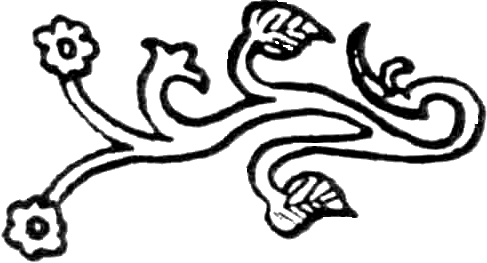
Bibliotekovedenie i bibliografiia: Ukazatel literatury.
Issued by Nauchno-metodicheskii cabinet bibliotekovedeniia of Gos. Biblioteka SSSR. V.I. Lenina. Moscow, 1958-1973.
U of I Library Call Number: Oak Street Facility 020.5 BIBLI
Bibliotekovedenie i bibliografiia: Ukazatel literatury continues Bibliografiia Bibliotekovedenii: Annotirovannyi Ukazatel . It is intended to be used by those in education and academia such as librarians, teachers, students and others associated with higher learning. It contains literature on the subjects of general theory and practice of library and bibliographic work, history of librarianship, libraries and bibliography, general problems of book trade, publishing, and informatics. The basis for selection was the obligatory depository copies received by Gos. Bib. Lenina, “Knizhnaia Letopis” and “Letopis gazetnykh i zhurnalnykh statei.”
Bibliotekovedenie i bibliografiia: Ukazatel literatury has a full account of books, brochures, articles from periodicals and continuing publications, sborniki, and publications in Russian and other languages of the countries of the former Soviet Union. The articles from sborniki are analyzed as are separate chapters from books of non-library themes in which general questions and connections to librarianship, librarians, and bibliography are present. All literature about children and school libraries is presented in a separate chapter. Articles from central and republic newspapers are included.
From 1958 to 1966, it was divided into two parts: the first part is literature regarding Russia and the former republics of the Soviet Union, and the second part is foreign literature given in the sections “Mezhdynarodnye organizatsii” , “Bibliotechnoe delo i bibliografiia za rybezhom” , “bibliotechnoe delo i bibliografiia v otdelnykh stranzkh” (Bibliographic information for publications published in countries such as Albania, Bulgaria, Great Britain, etc.), and “Inostrannaia pecham o bibliotechnom dele i bibliografii v SSSR” . Starting in 1967, there was only a separate section for “Bibliotechnoe delo v zarubezhnykh stranakh” .
From 1958 to 1966, this journal was published quarterly. For the researcher, the year 1958 can be confusing. For the year 1958, five issues were published with the year 1958 on the front cover. They are as follows: 1958:2 (inside cover, No. 2, April to June, 1957); 1958:3 (inside cover, No. 3, July to Sept., 1957; 1958:4 (inside cover, No. 4, Oct. to Dec., 1957); 1958:1 (inside cover, No. 1, Jan. to March, 1958); and 1958:2 (inside cover, No. 2, April to June, 1958). With the 1958:1 issue, the researcher will see the name change from Bibliotekovedeniia; Annotirovannyi Ukazatel to Bibliotekovedenie i bibliografiia: Ukazatel literatury . In the years after the name change, 1958, it is advisable to look both at the front cover, which may give only the year in which the issue was published, and the inside cover, which will definitely give the coverage dates. From 1967-1973, Bibliotekovedenie i bibliografiia SSSR: Ukazatel literatury was a monthly bibliography.
Every issue includes an extensive table of contents with main and sub topics and an alphabetical author and title index of books and articles. In later years, a list of indexed periodicals and journals and a list of abbreviations used are also given. Starting in 1970, a yearly index is included with number 12 of each year. (Note: sometimes only Bibliotekovedenie i Bibliografiia is on the front cover; at other times, Bibliotekovedenie i Bibliografiia: Ukazatel literatury is written.)
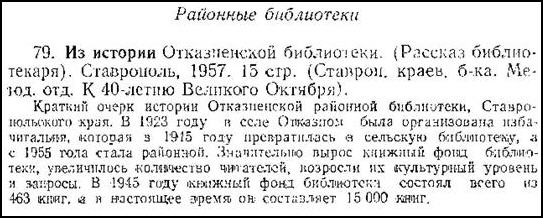
Bibliotekovedenie i bibliografiia: Ukazatel literatury is continued as Novaia Sovetskaia i inostrannaia litertura po bibliotekovedeniiu i bibliografii.

Novaia sovetskaia i inostrannaia literature po bibliotekovedeniiu i bibliografiia.
Issued by Informatsionnyi tsentr po problemam kultury i iskusstva of Gos. Biblioteka SSSR. V.I. Lenina. Moscow, 1974- Okt. 1975.
U of I Library Call Number: Main Stacks 016.02 N859
Novaia Sovetskaia i inostrannaia litertura po bibliotekovedeniiu i bibliografiia continues Bibliotekovedenie i bibliografiia: Ukazatel literatury. Novaia Sovetskaia i inostrannaia litertura po bibliotekovedeniiu i bibliografiia is intended for workers and specialists in librarianship and bibliography, and also teachers, graduate students, and those working at student institutions of culture and other higher learning. The bibliography includes information regarding the questions of theory and practice of libraries and librarianship, the history of library matters and bibliography, and general questions of book trade and the history of the book. Works devoted to questions on Informatics are treated selectively.
It includes books and brochures in Russian, in other languages of the former Soviet Union, and in European languages, articles from Russian and foreign sborniki, journals, and periodicals, and articles from central and republic Soviet newspapers. Bibliographic guides are not included except for the large complex and comprehensive ones that contain bibliographic and methodical materials. The basis for selection of material is as follows: the mandatory deposit of Russian publications received by the Gosudarstvennoi Bibliotekoi SSSR imena V. I. Lenina and new acquisitions of foreign books and periodicals. Russian literature is covered comprehensively while foreign literature is not, as books and articles are chosen for their depth and coverage of bibliographic and library studies.
Novaia Sovetskaia i inostrannaia litertura po bibliotekovedeniiu i bibliografiia was monthly. Citations are numbered consecutively throughout the year; that is, 1974:1 contains citations 1-307, 1947:2 contains citations 308-657, etc. An author and title index of books and articles and a list of journals and periodicals index are included at the end of the bibliography.
Novaia Sovetskaia i inostrannaia litertura po bibliotekovedeniiu i bibliografiia was continued as Novosti Nauchnoi Literatury: Bibliotekovedenie Bibliografovedenie (Sovetskaia Literatura).

Novosti Nauchnoi Literatury: Bibliotekovedenie Bibliografovedenie (Sovetskaia Literatura).
Issued by Informatsionnyi tsentr po problemam kultury i iskusstva of Gos. Biblioteka SSSR. V.I. Lenina. Moscow, Okt.1975-1978.
U of I Library Call Number: Main Stacks 016.0205 N859
Novosti Nauchnoi Literatury: Bibliotekovedenie Bibliografovedenie (Sovetskaia Literatura) continues Novaia Sovetskaia i inostrannaia litertura po bibliotekovedeniiu i bibliografiia . The goal of Novosti Nauchnoi Literatury: Bibliotekovedenie Bibliografovedenie (Sovetskaia Literatura) was to provide information about new Russian literature on theory, method, history and organization of library studies and bibliography, general questions of book trade and publishing, and the history of the book. It also included material regarding questions on informatics (presented selectively) in connection to informational and reference library work. The bibliography is intended for those studying and working in library and information science such as specialists, teachers, graduate students, and students of higher learning. It contains material about new publications in the Russian language and other languages of the former Soviet Union that were received by Gosudarstvennaia Biblioteka SSSR imena V. I. Lenina.
Included in the bibliography are monographs, articles from sborniki, journals and continuing publications, spravochniki, bibliographic and informational publications, dissertation abstracts, and reviews. Reviews of books are listed in sections corresponding to the subject of the reviewed work.
The bibliography is monthly. Note that the first issue says 1976:1 on the front cover, but on the inside title page it has the coverage dates of 1-31 Oktiabr, 1975 (no. 1-119). It is advisable to look at the inside title page for coverage dates because the year on the front cover may not necessarily be the year for which the material was indexed. For example, 1976:11 as indicated on the front cover seems like it would be for November, 1976; however, that issue is for 1-31 Avgusta, 1976 as indicated on the inside title page.
Every issue contains an alphabetical index of author and title names and a list of indexed journals and periodicals included in the bibliography. The last issue of each year contains a yearly index. Be aware that the yearly index does cover all issues for that year but may not necessarily cover all the months of that year. Months not covered will be represented in the next year’s annual index. The annual index for 1978 is divided into two parts: one in issue 1978:12 and the remainder in 1979. Citation number is consecutive throughout the year and begins anew each year.
Novosti Nauchnoi Literatury: Bibliotekovedenie Bibliografovedenie (Sovetskaia Literatura) is continued as Bibliotekovedenie i Bibliografovedenie v SSSR.

Bibliotekovedenie i Bibliografovedenie v SSSR.
Issued by Informatsionnyi tsentr po problemam kultury i iskusstva of Gos. Biblioteka SSSR. V.I. Lenina. Moscow, 1979-1983.
U of I Library Call Number: International & Area Studies Russian Reference and Main Stacks 016.02 B4712
Bibliotekovedenie i Bibliografovedenie v SSSR continues Novosti Nauchnoi Literatury: Bibliotekovedenie Bibliografovedenie (Sovetskaia Literatura). Beginning in 1979, the bibliography was issued as two series: “Bibliotekovedenie i bibliografovedenie v SSSR” and “Bibliotekovedenie i bibliografovedenie za rubezhom.” The series Bibliotekovedenie i Bibliografovedenie v SSSR informed about new publications by Soviet and foreign authors appearing in Russia and abroad regarding theory, methods, history and organization of library matters and bibliography in the SSSR, general questions of book trade and publishing and the history of the book, and also problems regarding informatics connected to information and reference work of libraries in the SSSR. The series Bibliotekovedenie i bibliografovedenie za rubezhom reflected publications in the SSSR and abroad regarding questions of foreign library matters, bibliography, book trade and publishing, and informatics.
Bibliotekovedenie i Bibliografovedenie v SSSR is intended for specialists, teachers, graduate students, and students of higher learning and also for those involved in informational bibliographic work of libraries and information services. The material reflects information about new publications chosen from the then current acquisition of literature from the Gosudarstvennaia Biblioteka SSSR im. V. I. Lenina and the All-Russian Gosudarstvennaia Biblioteka Innostrannoi literatury.
Included are monographs, articles from sborniki, journals and continuing publications, spravochniki, bibliographic and informational publications, dissertation abstracts, and reviews. Reviews of books are listed in sections corresponding to the subject of the reviewed work. The bibliography is monthly. As with the Novosti Nauchnoi Literatury: Bibliotekovedenie Bibliografovedenie (Sovetskaia Literatura), one must look at the inside title cover for coverage dates. For example, 1979:1 is for Nov. 1-30, 1978, 1979:2 Dec.1-31, 1978, 1979:3 is for Jan. 1-31, 1979, etc., 1979:12 is for Oct. 1-31, 1979. This was basically the same order with some variance in the last two months of the year for all issues of Bibliotekovedenie i Bibliografovedenie v SSSR.
Every issue contains an alphabetical index of author and title names and a list of indexed journals and periodicals included in the bibliography. The last issue of each year contains a yearly index. Be aware that the yearly index does cover all issues for that year but may not necessarily cover all the months of that year. Months not covered will be represented in the next year’s annual index. The annual index for 1978 was divided into two parts: one in issue 1978:12 and the remainder in 1979:1. In issue 1979:12, a yearly index representing all the issues for 1979 is included. Citation number is consecutive throughout the year and begins anew each year.
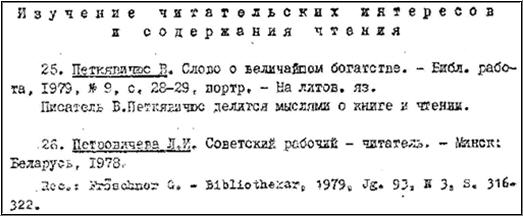
Bibliotekovedenie i Bibliografovedenie v SSSR is continued as Bibliotechnoe Delo i Bibliografiia v SSSR.

Bibliotechnoe Delo i Bibliografiia v SSSR.
Issued by Informatsionnyi tsentr po problemam kultury i iskusstva of Gos. Biblioteka SSSR. V.I. Lenina. Moscow, 1984-1991.
U of I Library Call Number: Main Stacks 016.02 B47122
Bibliotechnoe Delo i Bibliografiia v SSSR continues Bibliotekovedenie i Bibliografovedenie v SSSR. Bibliotechnoe Delo i Bibliografiia v SSSR informed about new Soviet and foreign publications appearing in Russia and abroad regarding theory, methods, history, and organization of library matters and bibliography in the SSSR. Emphasis was on scientific not popular work. As the other bibliographies before, this one is intended for specialists, teachers, graduate students, and students of higher learning, and also those in informational bibliographical work of libraries and information center. The other series Bibliotechnoe delo i bibliografiia za rubezhom reflected publications which came out in the Soviet Union and abroad on library matters in foreign countries.
In Bibliotechnoe Delo i Bibliografiia v SSSR , materials reflected new publications in Russian and other foreign languages of the SSSR which were chosen from acquired literature of the Gosudarstvennaia biblioteka SSSR imena V. I. Lenina and the All-Russian gosudarstvennaia biblioteka of foreign literature. Books and articles from journals, continuing publications and sborniki appearing in the languages of the nations of the former SSSR were sent in from the state libraries of the Soviet republics. Starting in 1984, entries regarding unpublished materials of bibliographic lists and guides and deposited manuscripts were put under the subjects to which they pertain. The bibliographic entries have consecutive enumeration within each year. Cross references were used for entries regarding two or more different subjects.
Bibliotechnoe Delo i Bibliografiia v SSSR was a monthly publication. In every issue, there is an alphabetical index that includes authors’ names, titles, editors, and reviewers, a list of other identifying access such as organization, publisher, place of publication, etc., and a list of periodicals and continuing publications indexed.

Bibliotechnoe Delo i Bibliografiia v SSSR is continued as Bibliotechnoe Delo i bibliografiia.

Bibliotechnoe Delo i bibliografiia.
Issued by Informatsionnyi tsentr po problemam kultury i iskusstva of Gos. Biblioteka SSSR. V.I. Lenina. Moscow, 1993-.
U of I Library Call Number: International & Area Studies Russian Reference (Slavic) and Main Stacks 016.02 B471221
Bibliotechnoe Delo i Bibliografiia continues Bibliotechnoe Delo i Bibliografiia v SSSR . Bibliotechnoe Delo i Bibliografiia has been published since 1974 by the Russian State Library and the M. I. Rudomino All-Russian State Library of Foreign Literature. From 1974-1992, it came out as two independent series, in which the foreign and domestic bibliography were separate. In 1993 the index became one series under the name Bibliotechnoe Delo i bibliografiia. It includes information about new publications which are received by the Russian State library and all Russian state libraries of foreign literature. It contains information about books, articles, periodicals, sborniki, dissertations, bibliographical materials, and reviews published in the languages of the nations of the Russian Federation. It also includes unpublished materials such as maps, calendars, booklets, etc. Materials range in nature from scientific studies to popular literature.
Bibliotechnoe Delo i bibliografiia comes out six times a year. The entries in Bibliotechnoe Delo i bibliografiia are organized alphabetically by author and title under main topics and their sub-topics. Entries include main entry (in bold) and complete bibliographical information. Abstracts are given after some entries. Reviews of books are put with the subject of the review.
Bibliotechnoe Delo i bibliografiia has an author index which includes authors, editors, reviewers, etc. Authors in Cyrillic are listed first, then those in the Latin script. Also, an index that includes organizations, institutions, geographical names, etc. is provided. In addition, a list of periodicals indexed is included. As the author index, Cyrillic entries are first, then Latin. Lastly, a table of contents is listed at the end of the index.
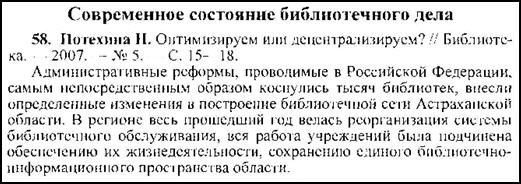

Other Bibliographies:
Bibliografiia Bibliotekovedeniia: Sistematicheskii ukazatel knig i statei na russkom iazyke no voprosam bibliotechnoi tekhniki.
Voltsenburg, Oscar Eduardovich, 1923
U of I does not hold. OCLC: 21640750
Bibliografiia Bibliotekovedeniia: Sistematicheskii ukazatel knig i statei na russkom iazyke no voprosam bibliotechnoi tekhniki is a systematic and recommendatory index. This bibliography has 179 entries with the earliest entry dating back to 1856. Entries are arranged chronologically under each section then subsections. Entries are annotated and arranged by author or title. Entries have consecutive numbering throughout the issues.
Many of the terms came from the journal Bibliotekar and its editor at the time Pavlu Mikhailovichu Bogdanovu. Other sources were L. B. Khavkinoi’s “Biblioteki, ikh organizatsiia i tekhnika” (2nd edition, 1911) and Medynskogo i Lapsheva’s “Sistematicheskom ukazatele knig i statei po vneshkolnomy obrazovaniiu” (Nauka, 1916).
It is divided into three volumes: Vypusk 1- Knigi i stati po bibliotechnoi tekhnike; Vypusk 2- Knigi i stati po istorii razvitiiu i sovremennomy polozheniiu bibliotechnogo dela v Rossii i zagranitsei; and Vypusk 3- Kulturnaia rol biblioteki, voprosy komplektovaniia bibliotek i podgotovki bibliotechnogo personala. Vypusk 1 is divided into two sections, I: Sochinenia, kasaiushchiesia bibliotechnoi tekhniki v tselom and II: Chastnye voprosy: bibliotechnoi tekhniki. Section II is further divided into rasstanovka i numeratsiia knig, katalogizatsiia, klassifikatskia knig, abonement, statistika i otchetnost, tekhnika peredvizhnykh bibliotek, bibliotechnaia gigiena, and bibliotechnoe zdanie i ero oborudovanie. There is an alphabetical index at the end.

Bibliotechnoe delo: bibliotekovedenie, bibliografiia, bibliografovedenie: annotirovannyi ukazetel bibliograficheskikh posobii, izdannykh v SSSR (1917-1987).
Zhurko, I. F., 1988, 139 p.
U of I does not hold. OCLC: 21034152
This bibliography lists materials on the questions of theory and practice of library and bibliographic activities, guides to the library and bibliographic publications of institutions, works of employees of institutions of culture, guides to the contents of periodicals and continuing publications, and personnel guides to library matters. Also included are separately published guides, current bibliographic publications, and bibliographies within books or articles and also following them. Not included are bibliographies of bibliographies including indexes and lists of bibliographic works published by separate libraries and persons.
Material in Russian and other languages of the former Soviet Union published there from 1917 to 1987 is represented. Works that lost their scientific value or have been duplicated by newer publications were not included. The most strongly represented are the nauchno-vspomogatelnye posobiia and weakly represented are the recommendatelnye (professionalno-proizvodstvennye). Material is divided into four main topics: I. bibliotechnoe delo, bibliografiia, obshchie voprosy; II. bibliotechnoe delo, bibliotekovedenie; III. bibliografiia, bibliografovedenie; and IV. personnel. Under each main topic except for personnel, there are many sub-topics and then sub-topics of those.
Bibliographic entries are given in Russian regardless of the language of the publication. Main entries are underlined and contain full bibliographic information and annotations. Annotations contain brief descriptions of the item and, in some cases, information such as the contents of journals. A name index, a title index, and an index of libraries and other institutions are provided at the end.
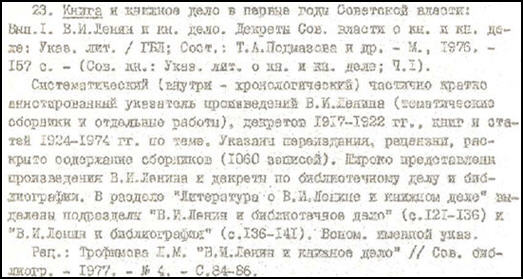

Bibliografiia bibliotekovedeniia: 1917-1927.
Orlov, N. N., 1928, 174 p.
U of I Library Call Number: International & Area Studies Microform (Slavic) MFICHE 016.020947 Or18b
Orlov’s Bibliografiia bibliotekovedniia: 1917-1927 was a corrected and enlarged edition of his Bibliografiia bibliotekovedeniia za gody revoliutsii (1917-1924). The library literature from the revolutionary years was also partly represented in B. S. Bodnarskii’s “Bibliografiia russkoi bibliografii,” O. E. Voltsenburg’s “Bibliografiia bibliotekovedeniia,” M. I. Slukhovskii’s “Bibliografiia biblitekovedeniia,” A. V. Mezer’s “Slovarnyi ukazatel po knigovedeniiu,” and “Literatura po voprosam narodnogo prosveshcheniia,” written by an anonymous author and appearing in the kharkovskii journal, “Put Prosveshcheniia.” Unfortunately, these works combined were not comprehensive for the library literature of the revolutionary years. In addition, Knizhnaia Letopis did not index all books during those years. As of 1923, books were coming in more regularly to Knizhnaia Palata, but lack of publishing resources caused them to be very selective as to which to include in Knizhnaia Letopis.
Bibliografiia bibliotekovedeniia: 1917-1927 contains descriptions of individual publications, appearing in Russian and other languages of the territories of the former Soviet Union. It also contains works on questions of Russian library matters, published abroad (except for leaflets less than two pages). As mentioned, this bibliography is not comprehensive because it was difficult to collect during revolutionary years. Provincial publications were especially difficult to collect because of the separation of the center from the provinces. Overall, 90% of the material published about library science during those years was included.
The majority of the material was described de visu, and the remainder was based on Knizhnaia Letopis and a few other sources. The items not checked de visu were marked with an asterisk. This ukazatel was organized by Classification decimale universelle; within each chapter the contents were listed chronologically. After the bibliographic information about the item, reviews were given. There was no material about izba-chitalnia units.
There is an author index, an index of anonymous publications, an index according to city, and an index according to language. There is also a list of journals from which reviews were taken. A detailed table of contents is provided at the end.
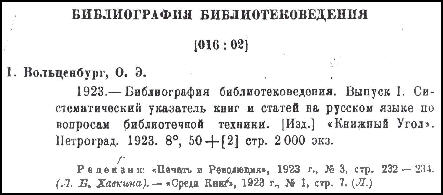

Otechestvennaia bibliografiia: 1917-1929.
Fokeev, V. A., 1992, 213 p.
U of I Library Call Number: International & Area Studies Russian Reference 015.47 F739o
Otechestvennaia bibliografiia: 1917-1929 includes descriptions of scientific Soviet publications from journals and sborniki that appeared in territories of the former Soviet Union from January 1917 until December 1990 in all languages including foreign ones. For formal technical reasons, the descriptions of foreign language publications were given in translations into Russian.
Otechestvennaia bibliografiia: 1917-1929 was not comprehensive. They did publish some of the counter revolutionary literature and more important publications from the areas of publishing, archives, museums, book sales, and library science. They excluded books on library personnel with the exceptions of publications of a general nature. Reviews of foreign bibliographic sources were not included because these were already shown in the work of Iu. Masanov “Teoriia i pratika bibliografii: Ukazatel literatury, 1917-1958.” Masanov included material on the works of Lenin and the party and governmental documents.
Material was arranged according to their own system of Dewey and within their own subdivisions. They listed material chronologically. The entries were based on catalog of the Russian State Library and also the published and unpublished works of B. S. Bondarskii, I. V. Vladiclavlev, M. N.Kufaev, Iu. I. Masanov, A. V. Mezer, G. L. Levin, A. G. Fomin and other specialists.
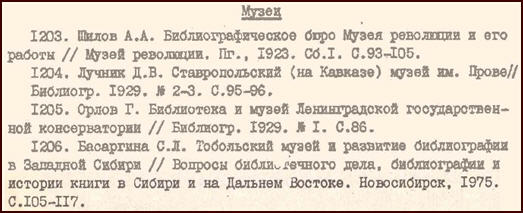

Bibliotechnoe delo v pervye gody sovetskoi vlasti (1917-1920).
Compiled by L. D. Dergacheva, V. A. Zimina, T.G. Tiutiaeva, Moskva, 1973, 226 p.
U of I Library Call Number: International & Area Studies Russian Reference Q.016.020947 B4711991
Bibliotechnoe delo v pervye gody sovetskoi vlasti (1917-1920) includes material about library matters from the years 1917 to 1920 published from 1917 to 1970. Special attention was given to any material produced by Lenin on libraries as well as that of his wife N. K. Krupskoi. It includes government decrees related to libraries, instructional and statistical materials, resolutions, conferences, lectures, and library reports.
A chapter is devoted to the leading role the Communist party of the former Soviet Union took regarding library work. Examples of chapters are as follows: library work in the first years of Soviet power; state management of libraries; organization and technology of the work of libraries; and the education of library cadres.
Books, documentary publications, journal articles, sborniki articles, reviews, and dissertation abstracts published in the Russian language in the territories of the former Soviet Union were selected for this bibliography. Central and provincial materials published separately and in supplements were also included. In addition to monographs, research articles, and dissertation abstracts, the bibliography includes textbooks and study materials for colleges and universities. Explanatory annotations are provided with some entries.
The basis for materials comes from the Russian State Library, the Russian State Historical Library, the Library of the Academy of Sciences, the Russian National Library, etc. In addition, library guides and bibliographies on library matters were used.
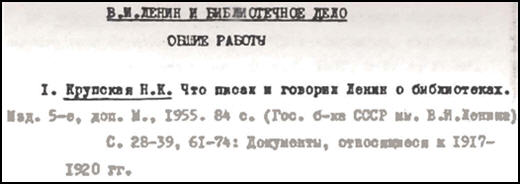

Bibliograficheskie izvestiia: zhurnal, izdavaemyi russkim bibliograficheskim obshchestvom pri moskovskom universitete.
Moskva, 1913-1929.
U of I Library Call Number: International & Area Studies Russian Reference 016.891705 BIB v.1-17
Bibliograficheskie izvestiia: zhurnal, izdavaemyi russkim bibliograficheskim obshchestvom pri moskovskom universitete includes a section called Bibliografiia russkoi bibliografii written by B. S. Bodnarskii. Bibliografiia russkoi bibliografii includes works dedicated to bibliography in the strict sense such as theoretical works, guides, catalogs of book sellers, etc. Also included were materials about the history of libraries, economy of libraries, and catalogs. Books, brochures, articles from journals and newspapers, and book chapters were included. They also included reviews of bibliographic works, and the reviews were placed with their subject matter rather than with their authors.
Inclusion of material was based on Knizhnaia Letopis which came out weekly at the time. They had to be selective because of the sheer volume of material produced. In regards to periodical literature, they limited materials to certain journals including Russkii Bibliofil, Bibliotekar, Knizhnyi Vestnik, and Novosti detskoi literatury. They also consulted journals of a general nature such as Izvestiia Imperatorskoi Akademii Nauk and newspapers such as Russkii Vedomosti and Russkoe slovo. Bibliographic description was based on the standards of the International Bibliographic Institut.
Bibliografiia russkoi bibliografii appeared in Bibliograficheskie izvestiia as follows: quarterly in 1913; in two sections za ianvar to iiun and za iiul to dekabr from 1914 to 1920; in one section, bibliograficheskaia literatura za ianvar to dekabr, in 1921, 1922, and 1923 respectively; two sections, one for 1924 and one for 1925 in the 1925 issue; and one section for 1929. Although they were intended for publication, there was none from 1926 to 1928. In 1922, there was also an alfavitnyi ukazatel avtorov k “bibliografii russkoi bibliografii” za 1918-1922.
Bibliografiia russkoi bibliografii was later published independently in the following volumes: tom 1 s 1913 g. po 1917 g. vkliuch; tom 2 s 1918 g. po 1922 g. vkliuch; tom 3 s 1923 g. po 1925 g. Vkliuch; and tom 4 za 1929 god. In addition to its holdings for Bibliograficheskie izvestiia , The University of Illinois at Urbana Champaign holds the independently published third volume for 1923 to 1925 (U of I Library Call Number: Slavic Reference 016.01547 B63b).


Teoriia i praktika bibliografii: ukazatel literatury, 1917-1958.
Masanov, Iu., 1960
U of I Library Call Number: Main Stacks and Oak Street Facility 016.01 M38T
The main part of Teoriia i praktika bibliografii: ukazatel literatury, 1917-1958 contains literature about the questions of theory, history, methodology, and practices of bibliography published in the former Soviet Union from 1917 to 1957 and also most from 1958. The main part includes those books and articles that were completely devoted to issues regarding bibliographic research.
Books were registered regardless of the language of the work. Articles from periodicals were mostly in Russian; however, articles from several special periodical publications in other languages of the republics of the former Soviet Union were also included. Examples of these are the journal Bibliologichni visti, bibliograpiis moambe, and several others. Concerning articles about separate libraries, only those which were entirely devoted to bibliographic work were included. General textbooks on library work, multi-part publications on propaganda knigi, and similar books were not included. Rotaprint and small print run publications were partly represented since these were not often presented to the Vsesoiuznaia knizhnaia palata.
The index fully included the contents of the sborniki Sovetskaia bibliografiia from 1933 to 1958 and its predecessors, the journals Bibliografiia, bibliografiia i bibliotekovedenie, and the sbornik bibliografiia and i rabota nauchnykh bibliotek . Since some materials published in the above mentioned publications go beyond the boundaries of the subject of this ukazatel, they were listed in a separate prilozhenie no.1. Reviews of bibliographic guides were listed in prilozhenie no. 2; however, only reviews from 1933 to 1958 on the material of Letopisi retsensii, Vsesoiuznaia knizhnaia palata were included.Most material was described de visu. There are three indexes: author, title, and personalii.
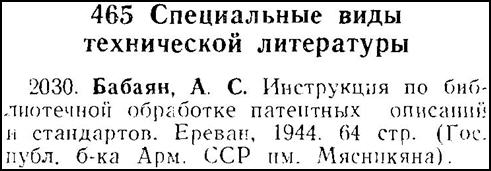

Bibliografiia, bibliografovedenie: ukazatel literatury, izdannoi v SSSR na russkom iazyke v 1959-1984 gg: v 8 chastiakh.
Sostavitel G. L. Levin, nauchnyi redactor V. A. Fokeev, Moskva, 1993-1998.
U of I Library Call Number: International & Area Studies Russian Reference (Slavic) 016.01 B475 (also on FILM 016.01 B475 in History, Philosophy, & Newspaper)
Bibliografiia, bibliografovedenie: ukazatel literatury, izdannoi v SSSR na russkom iazyke v 1959-1984 gg: v 8 chastiakh chronologically continues Iu. I. Masanov’s “Teoriia I praktika bibliografii” (M. 1960). The index is intended for scientific work by bibliographers, teachers of bibliographic disciplines, graduate students, and specialists from closely related fields. The main sources were the currently published guides on library science and bibliographies and the State bibliographic materials.
Books, brochures, official and legal documents, author dissertations, deposited manuscripts, journal articles, reviews, and other materials from continuing publications and non-continuing sborniki in the Russian language published from 1959 to 1984 were included. Works in Russian by Soviet authors published abroad, publications from international institutions, and works published in 1958 that did not make it into Masanov’s Teoriia i praktika bibliografi: ukazatel literatury, 1917-1958 were also included. Selectively, they incorporated the most important articles from encyclopedias and popular publications, including reviews of bibliographic works. Reviews of bibliographic works are listed at the end of the subject chapters. Not included were works that were published in print runs smaller than 100 items.
The index was published in eight parts. In the first part, there is a forward for the entire publication, a list of contents for all eight parts, a list of abbreviations for periodical and continuing publications, and a list of institutions and organizations. Each volume is numbered separately. In the eighth part, there are navigational indexes by authors, editors, reviewers, etc. and by institution and organization. Short annotations were provided if the title and subtitle did not give a clear representation of the work.


Bibliographies of Bibliography
Bibliograficheskie Materialy: Opis’ knig, broshiur i statei biblioteki.
Smirnov, N. P., 1898, 690 p., 2 volumes.
U of I Library Call Number: International & Area Studies Russian Reference 015.47 Sm48bFACSIM
HathiTrust full-text link : http://hdl.handle.net/2027/mdp.39015023465951
Bibliograficheskie Materialy: opic knig, broshiur i statei biblioteki is a very important source since it was the only work that had bibliographical information for that time period. This bibliography is based on the Imperial Public Library and the private library of P. Krasheninnikov. Book sellers also participated in this bibliography as they gave Smirnov hard to find items. Thus, he was able to get limited print runs of books and periodicals and include them in his bibliography.
Bibliograficheskie Materialy: opic knig, broshiur i statei biblioteki is divided by subjects. Since some books fell under more than one subject, Smirnov gave cross references to other chapters at the end of each chapter. Each entry includes year of publication, printing house, number of pages and format, and also a brief summary of its contents.
There are five chapters:
- Chapter 1: Paleografiia
- Chapter 2: Knigopechatanie i zakony o tsenzur i pechat
- Chapter 3: Bibliografiia
- Chapter 4: Biblioteki, muzei i arkhivy
- Chapter 5: Knizhnaia torgovlia


Bibliografiia sovetskoi bibliografiza za..g/Vsesoiuznaia knizhnaia palata.
Moskva: Izd-vo Vsesoiuznoi knizhnoi palata, 1939-1991.
U of I Library Call Number: Main Stacks and Oak Street Facility 015.47 V96b
Continued by
Bibliografiia rossiiskoi bibliografii/Rossiiskaia knizhnaia palata.
Moskva: Izd-vo “Knizhnaia palata,” 1992-.
U of I Library Call Number: Main Stacks Reference and Oak Street Facility 015.47 V96b1
These bibliographies of bibliographies contain extremely useful sources for research on almost any subject in Russia and the former Soviet Union. They include the following sources: a) separately published bibliographic works; b) current bibliographic publications; c) vnutriknizhnye i vnutrizhurnalnye bibliographical indexes, lists, and reviews; d) priknizhnye i pristateinye bibliographic lists; and e) historical reviews.
The table of contents has changed since 1992 hence the sections on library and information science have fallen under different main headings and sub-headings. From 1956-1991, library studies was under different main headings such as Kultura, Pechat. Knigovedenie. Poligrafiia, and Pechat. Knigovedenie. Bibliotechnoe delo. In 1992, when the bibliography changed names, the library section was under the main heading “Kultura. Kulturnoe stroitelstvo” and had sub headings such as biblitoechnoe delo, bibliotekovedenie, bibliografiia, bibliografovedenie, and muzeinoe delo, myzeevedenie. From 1993 to 2005, the library and bibliography section were under the main heading “Gumanitarnye nauki v tselom.” Examples of sub-headings are as follows: Bibliografiia. Katalogi. Ukazateli literatury; Bibliotechnoe delo. Bibliotekovedenie; and Rukopisi. Redkie knigi (sub-headings changed slightly year to year). Be aware that in 2006 sections were divided under the Russian internal classification system; however, headings and sub-headings were still very similar.

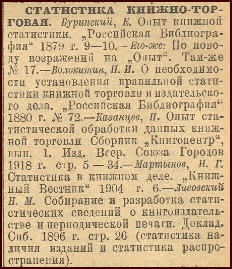
Slovarnyi Ukazatel po Knigovedeniiu.
Mezer, A. V., 1924, 926 columns.
U of I Library Call Number: Main Stacks 016.016 m57s; History, Philosophy, & Newspaper FILM 016.016 M57S
Slovarnyi Ukazatel po Knigovedeniiu is a dictionary index containing more than two hundred entries. Chronologically material for this index ends in 1923, but a few entries are from 1924 are included. Included were only bibliographic works of general character. Mezer omitted highly specialized bibliographies and only gave a limited description of journals and newspapers that were described by A. N. Neustroev ( Ukaztel k russkim povremennym izdaniiam i sbornikam za 1703-1802 i k istoricheskomu rozyskaniiu o nikh, Slavic Reference 016.057 N39u1963) and N. M. Lisovskii. Mezer attempted to provide extra information that one cannot find in those two works.
Slovarnyi Ukazatel po Knigovedeniiu contains articles, periodicals, catalogs, bibliographies, lists, spravochnik, indexes, trudy, etc. Mezer included both general periodicals and those of a book and library nature. Entries begin with a slash then author, name of the journal, book, etc, and more bibliographic information. It can be a little difficult to sort through the entries, but it is well worth it due to the wealth of information included in each entry. Different types of fonts were used to make entries more readable.
Underground and revolutionary journals are not described separately but are subsumed under the entry for foreign journals. The Soviet periodical press can be found in the addendum Dopoleniia, str. 795-800 under the name Gazeta by Sovetskoi Rossii.

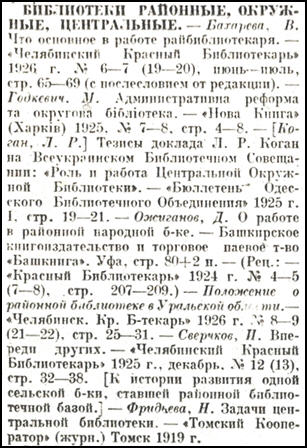
Slovarnyi Ukazatel po Knigovedeniiu.
Mezer, A. V., 1931, 3 volumes.
U of I Library Call Number: International & Area Studies Microform (Slavic) Fiche 016.016 m57s1931
Slovarnyi Ukazatel po Knigovedeniiu, 1931 was a supplement/addendum to the 1924 Slovarnyi Ukazatel po Knigovedeniiu. There are three volumes: Volume 1 A-Zh; Volume 2 Z-P; and Volume 3. R-Ia. Chronologically, material stops in 1926, but in special cases literature from 1927-1930 was included. Exceptions were books and journal articles which talked about the underground revolutionary press because at that time this area was just being studied.
There were new entries such as avtor as well as new information for entries given in the 1924 Ukazatel. New entries reflected new areas of research such as bibliosotsiologii and biblioekonomiki. There were many new entries having to do with journalism and newspaper publishing in general. There was also some reshuffling of material. For example, bibliographic and library journals were moved into the heading knigovedcheskie zhurnaly with a whole series of subheadings (p.IX). The entry names themselves provide distinctions between information about Russia and other republics of the former Soviet Union such as biblioteki natsmenshinstv. Names of famous censors such as Krasovskogo and other more minor ones were included.
At the end of Volumes 1, 2, and 3, there are lists of spisok slov that gives concepts and terms with cross references and page numbers for that particular volume. In Volume 1, there are two lists, one for Volume 1:A-Zh and one for Volume 2:Z-Ia. At first, Mezer intended Volume 2: Z-Ia to be just one volume, but it had to be divided into two parts: Volume 2:Z-P and Volume 3:R-Ia. In volume 3, in response to criticism from the Soviet press, the publisher apologized for some of the content in volumes 1 and 2 as it did not meet the newly defined goals of knizhnogo stroitelstva. As a result, there is a lengthy supplement containing information about proclamations and the underground press at the end of volume 3. The publisher also told that there was no name index included in volumes 1-3; however, one would be published as a separate entity in 1935 (unfortunately, this was never published).

Encyclopedias
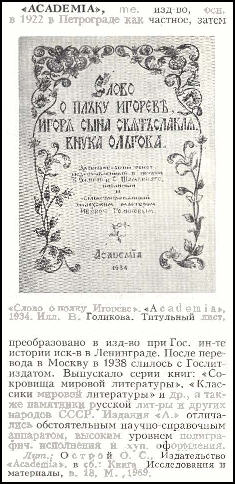
Knigovedenie: entsiklopedicheskii slovar.
redaktsionnaia kollegiia N. M. Sikorskii (glav. Red.), 1982, 661 p.
U of I Library Call Number: International & Area Studies Russian Reference (Slavic) 002.03 K748
This one-volume encyclopedia lists entries involving all aspects of book related issues such as the history of the book, book trade, publishing, and library science in Russia. Some entries stand by themselves and others such as book trade and publishing are composed of several parts each with its own sub-title. After entry titles of foreign persons or journals, names and titles are also given in their original language. As most encyclopedias, articles are arranged in alphabetical order. Illustrations are located in the text of the entries and as separate insets. Especially valuable are the detailed bibliographies provided after most entries. Authors’ names are listed after most entries.
Knigovedenie: entsiklopedicheskii slovar has an extensive index that includes names, institutions, businesses, organizations, societies, periodicals, and continuing publications on book studies. In addition, names of literary figures, political personalities, scientists, artists, cultural figures, editors, bibliographers, librarians, etc. are included. Page numbers are either in bold representing a separate entry or plain type representing only a brief mention. This encyclopedia also offers a short index of non-Russian terms in the Latin alphabet, an abbreviation list, and an author list.

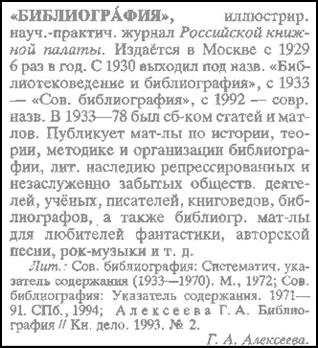
Kniga: Entsiklopediia.
Glavnyi redaktor V. M. Zharkov, 1999, 796 p.
U of I Library Call Number: International & Area Studies Russian Reference (Slavic) and Main Stacks 002.03 K7482
This one-volume encyclopedia is an update of the previously mentioned encyclopedia by N. M. Sikorskii. It consists of a single series of articles, arranged in alphabetical order, covering the whole range of book-related topics: the history of the book and publishing in Russia and other countries, including those that have emerged with the breakup of the Soviet Union; biographies of key Russian and foreign figures in publishing; book arts and the technical, legal, and aesthetic aspects of book publishing and bibliography; libraries; publishing houses; organizations; and historical and theoretical articles on a variety of topics. Articles range in length from one to two paragraphs to a few pages in length. As with the Knigovedenie: entsiklopedicheskii slovar, some entries are composed of several parts each with its own sub-title. In addition, the volume is beautifully illustrated with many of the pictures in color. Most entries supply at least one or two citations to important literature on the subject with some providing very detailed bibliographies.
As Knigovedenie: entsiklopedicheskii slovar, Kniga: Entsiklopediia has an extensive index that includes names, institutions, businesses, organizations, societies, periodicals, and continuing publications on book studies. In addition, names of literary figures, political personalities, scientists, artists, cultural figures, editors, bibliographers, librarians, etc. are included. Page numbers are either in bold representing a separate entry or plain type representing only a brief mention. This encyclopedia also offers a short index of non-Russian terms in the Latin alphabet, an abbreviation list, and an author list.

Dictionaries
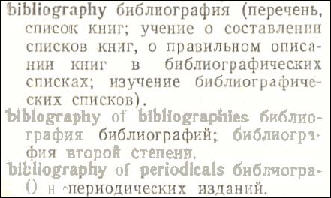
Anglo-russkii bibliotechno-bibliograficheskii slovar.
Compiled by M. Kh. Saringulian, 1958, 284.
U of I Library Call Number: International & Area Studies Russian Reference and Oak Street Facility 020.3 S243A
Anglo-russkii bibliotechno-bibliograficheskii slovar contains more than 11,000 terms and other words used in library and bibliographical work, an extensive section of abbreviations from library literature in English, spravochnye tablitsy , and several hundred individual illustrations depicting terms from fundamental ideas. Besides library and bibliographical terms, the dictionary also gives terms and abbreviations regarding printing trades, book publishing, book trade, photography, micro-reproduction, sound recordings, and cinematography. For the English equivalents, terms were taken from library and bibliographic literature in the United States, England, Australia, Canada, New Zealand, and India.

Anglo-russkii slovar bibliotechnykh terminov.
Compiled by V. F. Sakharov and T. P. Sokolova, 1941.
U of I Library Call Number: International & Area Studies Russian Reference 020.14 sa29a
Anglo-russkii slovar bibliotechnykh terminov contains more than 1,600 terms. Terms from library science and bibliography, typography, publishing, and the history of the book are included. To present a complete review of specialist terms, the authors included elementary words such as book and library and other words one often comes across in library literature.

Anglo-russkii slovar po bibliotechnoi i informatsionnoi deiatelnosti.
Compiled by John V. Richardson, 2005, 266 p.
U of I Library Call Number: Main Stacks and Oak Street Facility 020.3 An46r
Anglo-russkii slovar po bibliotechnoi i informatsionnoi deiatelnosti contains words and expressions used in library and information areas. Terms from the following disciplines are included: bibliography, book trade, graphics, information science and computer technics, publishing and typographical matters, and also telecommunications. Terms from various disciplines were selected in accordance with their use in library science. Slang is not included. Terms are given in English with a Russian translation. A list of literature consulted is provided.
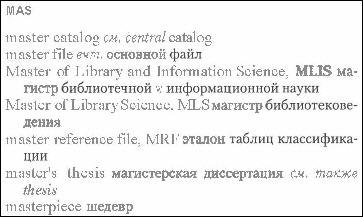

Bibliografiia Osnovnye Poniatiia i Terminy.
Simon, Konstantin Romanovich. Moskva, 1968. 158 p.
U of I Library Call Number: Oak Street Facility 010.3 Si54b
Bibliografiia Osnovnye Poniatiia i Terminy contains 125 specialized terms and expressions on the theory of bibliography. Examples include “annotirobannaia bibliografiia,” “bibliografiia bibliografii,” “bibliografiia dissertatsii,” and “retrospektivnaia bibliografiia.” The descriptions are very detailed. Some entries have a short bibliography, which are very useful to the researcher. At the end of the book, there is a bibliography that gives further sources for the study of bibliographical terminology and history.

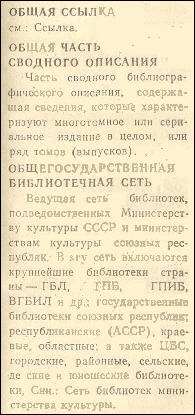
Bibliotechnoe Delo: Terminologicheskii Slovar.
Redatsionnaia kollegiia N. S. Kartashov et al.; sovtaviteli I. M. Suslova, L. N. Ulanova, 1986. 223 p.
U of I Library Call Number: Main Stacks 020.39171 B471
Bibliotechnoe Delo: Terminologicheskii Slovar was published ten years after the appearance of Slovar bibliotechnykh terminov by O. S. Chubariana. During that time, the terminological system of library studies had become very dynamic and had changed greatly. In all areas of library terminology, new terms were popping up constantly. For example, there was a whole new group of terms connected with central bibliographic networks such as vnytrisistemnyi obmen, edinyi fond tsentralizovannoi bibliotechnoi sistemy, mezhvedomstvennaia tsentralizatsiia, mezhzavodskaia i mezhsoiuznaia biblioteka, bibliotechnyi territorialnyi kompleks, etc.
One can also find other ideas and notions that had not occupied such importance in library science before. The meanings of terms such as bibliotechnoe resursi had broadened greatly to reflect the radical restructuring of the conceptual apparatus of library matters. In addition, new laws clearly defined terms such as library, library systems, and nauchno-metodicheskaia rabota . Other terms such as centralized library system and library technology which at that time were still being established and discussed were clearly defined in Bibliotechnoe Delo: Terminologicheskii Slovar. Lastly, other terms entered the vocabulary of library science from other disciplines such as sociology, psychology, pedagogy, and computer science.
There are close to 1,300 terms that reflect various groups of library concepts: theory and organization of library matters, types of libraries, library management, library collections and catalogs, library service, and reading. Also included are fifty informatics related terms. A list of additional literature by subject, a list of abbreviations, and a systematic index of terms are provided.

Bibliotechnoe Kraevedenie: 200 Terminologicheskii Slovar.
Issued by Ministerstvo Kultury Rossiiskoi Federatsii Sankt-Peterburgskaia gosudarstvennaia akademiia kultury, 1998.
OCLC: 41503759
Bibliotechnoe Kraevedenie: 200 Terminologicheskii Slovar is a highly specialized dictionary intended for those studying bibliotechnoe kraevedenie in Russia. It lists basic concepts dealing with Russian library and bibliographic kraevedenie and short biographies of people active in that area. Some entries include short bibliographies.

Russko-angliiskii slovar knigovedcheskikh terminov.
Compiled by Edizarenkova, T. P., 1969. 264 p.
U of I Library Call Number: International & Area Studies Russian Reference (Slavic) and Oak Street 010.3 EL4R
Russko-angliiskii slovar knigovedcheskikh terminov contains 9,300 terms on book science, bibliography, librarianship, publishing, printing, the book trade, and to some degree scientific information. It is based on an examination of the leading works on book and library science including reference books, special periodicals, and monographs in Russian as well as English. In some instances where there was not an established or equivalent Russian term, a brief explanation in English was provided.

Russko-anglo-frantsuzskii terminologicheskii slovar po informatsionnoi teorii i praktike
Zhdanova, G. S. et al., 1968, 239 p.
U of I Library Call Number: International & Area Studies Russian Reference 010.3 R921
Russko-anglo-frantsuzskii terminologicheskii slovar po informatsionnoi teorii i praktike was based on the issue of Referativnyi zhurnal named “Nauchnaia i Tekhnicheskaia Informatsiia” which appeared in 1963 in addition to other periodicals regarding information themes. 1,281 terms are included. There are three parts: the first part includes consecutively numbered terms with descriptions in Russian and their English and French equivalents; the second part consists of an English alphabetical index; and the third part a French alphabetical index. A short bibliography is provided.
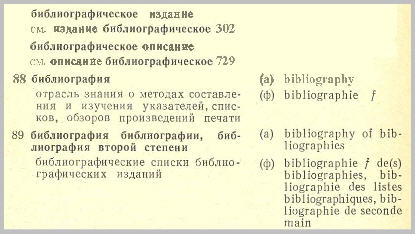

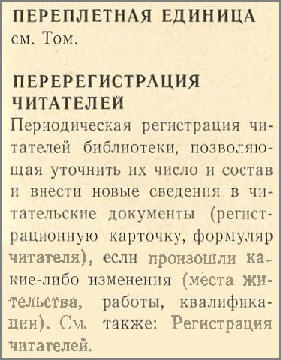
Slovar Bibliotechnykh Terminov.
Chubariana, Ogan Stepanovich, 1976. 222 p.
U of I Library Call Number: Main Stacks 020.3 S634
Slovar Bibliotechnykh Terminov aimed to serve as a reference work for a wide circle of people involved in library work: librarians, information specialists, teachers and students of higher learning, and specialists of related disciplines. It included new terms and updated definitions and meanings introduced since the time of E. I. Shamurina’s Slovar Knigovedcheskikh Terminov .
There are 500 terms reflecting the following groups of library concepts: library matters, library science, organization of library work, library collections and catalogs, work with readers, and reading matters. Special attention was given to the selection of new terms, the most significant of which reflected the development of progressive forms of library service, automation, and mechanical library work. There were also terms such as model fonda, organizatsiia truda v biblioteke, koordinirovannoe komplektovanie, mashinnyi catalog, prognozirovanie bibliotechnogo dela, sotsiologiia chteniia, psikhologiia chteniia and many other new terms that had not been explained before the publication of this dictionary. Also included were already established terms whose meanings and nuances had become broader. Examples of these terms were as follows: ekonomika bibliotechnogo dela, normirovanie bibliotechnykh protsessov, krug chteniia, and otkrytyi dustup k fondam. A list of articles and books by subject for further research was provided at the end.

Slovar Knigovedcheskikh Terminov.
Shamurin, Evgenii Ivanovich, 1958. 340 p.
U of I Library Call Number: Oak Street Facility 010.3 SH17S
Slovar Knigovedcheskikh Terminov is an invaluable source for librarians, bibliographers, those in the printing and book industries, and anyone researching library studies in Russia. It contains more than 4,500 terms and expressions. The dictionary includes the following four categories of information: general book industry terminology; library terminology; bibliographical terminology; and terminology from closely-related fields.
Terms come from a wide range of theory and practice of Soviet library matters, bibliography, book industry, and editing and publishing work. Also included were new terms widely distributed in the world of book industry literature at that time, terms from Soviet articles and speeches, and out of date Russian and foreign terms regarding the Russian book industry literature of the nineteenth century and the beginning of the twentieth century up until the 1930s.

Slovar terminov po informatike na russkom i angliiskom iazykakh.
G. S. zhdanova, E. S. Kolobrodova, B. A. Polushkin, A. I. Chernyi, 1971.
U of I Library Call Number: International & Area Studies Russian Reference 010.3 Sl58
Slovar terminov po informatike na russkom contains 3,035 terms about informational theory, methods, and practice. There are 48 thematic divisions. The dictionary is divided into four parts: the first part consists of Russian terms with their descriptions or interpretations and English equivalents; the second part consists of an alphabetical index of terms in Russian; the third part consists of an alphabetical index of terms in English; and the fourth consists of Russian and English abbreviations used.
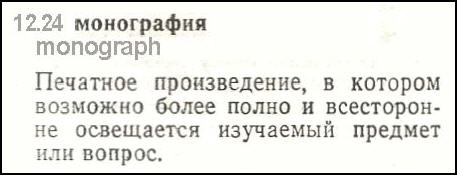

Handbooks
Spravochnik Bibliotekaria.
Redaktsionnaia kollegiia N. S. Kartashov, 1985. 302 p.
U of I Library Call Number: International & Area Studies Russian Reference (Slavic) 027.047 SP76
Spravochnik Bibliotekaria was the first attempt to create a ready reference handbook for librarians. Material was selected to fulfill the needs of the workers in smaller libraries. However, it was also meant to be of interest to a wide circle of library workers and students specializing in library studies. Topics covered include katalogizatsiia, kartoteki, bibliotechnoe obsluzhivanie chitatelei, and mezhdynarodnye bibliotechnye organizatsii, among many others. Some chapters have charts and graphics to present information. Not included was material regarding general questions of technological work in libraries, and also connections to historical character and biographical information. Sources including references to laws and decrees for further reading are provided after each section. A subject index is provided.
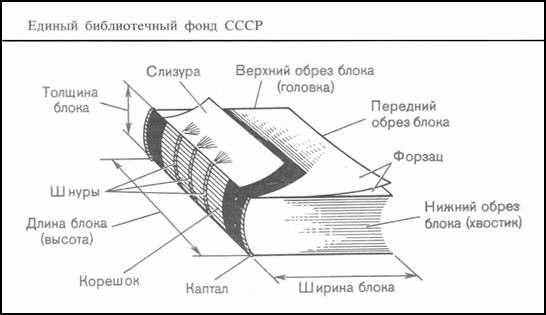

Statistics
Pechat SSSR: statisticheskie sbornik.
Vsesoiuznaia knizhnaia palata, 1922-1934.
U of I Library Call Number: International & Area Studies Russian Reference (Slavic) and Oak Street Facility 077 V969p
Pechat SSSR: statisticheskie sbornik contains statistical data concerning the publishing industry from 1922-1934. It was published by the Rossiiskaia Tsentralnaia Knizhnaia Palata (Russian Central Book Chamber), which was relatively new at that time. A very descriptive organizational chart of the Russian Central Book Chamber is provided.
Prefacing the statistical charts is a section entitled Statisticheskie materially po pechatnoi produktsii RSFSR v 1922 by A. Borovskii. The statistical charts section is divided into two parts: Statisticheskie Tablitsy A: Neperiodicheskaia pechat; and Statisticheskie Tablitsy B: Periodicheskaia pechat. In the Neperiodicheskaia pechat section, there are many charts some of which are Obshchaia svodka kolichestva knig, Sregnii obem i tirazh, and Raspredelenie knig po otdelam desiatichnoi sistemy, vidam izdatelstv i po mesty izdaniia. The Periodicheskaia pechat statistical data are divided by type such as bibliograficheskie, filosofskie, and iskusstva, and then by geographic locations. The data are also divided by criteria such as 2 raza v mesiats, 1 raza v mesiats, and 2 i bolee raz v nedeliu, etc. Bar graphs and pie charts are also included. There is also a chapter entitled Russkaia Kniga v 1922 gody at the end.
Pechat SSSR: statisticheskie sbornik was not published in 1923, 1925, 1928-31. It was published under the following names for the pertinent years: Pechat RSFSR in 1922 and 1932-33; Kniga v SSSR in 1924; and Knizhnaia produktsiia in 1927 (one may need to search under this title). Subtitles varied slightly. Volumes for 1922-27 were issued without subtitles.
Pechat SSSR: statisticheskie sbornik is continued by Pechat SSSR v … godu.
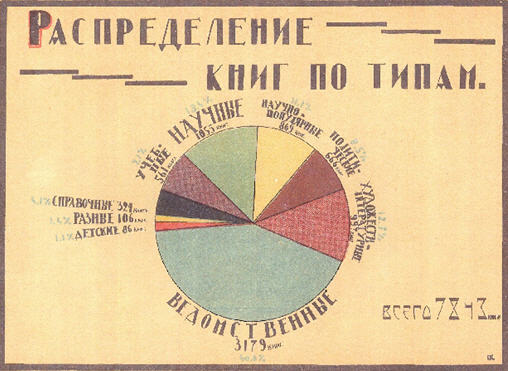

Pechat SSSR v … godu.
Vsesoiuznaia knizhnaia palata, 1935-1991.
U of I Library Call Number: Main Stacks 655.447 P332
Pechat Rossiiskoi Federatsii v … godu.
Nauchno-proizvodstvennoe obedinenie, Vsesoiuznaia knizhnaia palata, 1992-.
U of I Library Call Number: International & Area Studies Russian Reference (recent volumes) 070.50947 P3322 and Main Stacks for previous volumes.
Pechat SSSR v … godu and Pechat Rossiiskoi Federatsii v … godu contain basic quantitative and qualitative indexes, which characterize the publishing industry of the Soviet Union and later the Russian Federation and the individual republics/regions. They are divided into two parts: the first part includes statistical information, which generalizes the results of publishing activities in the Soviet Union and later the Russian Federation; and the second is devoted to the publishing activities of the republics of the Soviet Union and later the Russian Federation. The statistical calculations of the publishing industry are based on official copies of publications put out in the given year. For a unit of counting, they took a physical public object whether it was a book, brochures, a volume of a collected work, every journal issue, newspaper, post card, leaflet, list, reproduction, etc. For a book they considered non-periodical publications that were bound and had more than 48 pages (during Soviet times); for brochures, they considered non-continuing publications in the form of several bound pages between 4 and 48 (during Soviet times).
Informational materials in this sbornik are classified according to subject, by purpose, by language, by genre, by publication, and also by ministries’ committees and other bodies which produced these items outside of regular publishing houses. Included is information about the basic forms of publishing production: non-continuing publications (books and brochures; author dissertations and tear-off daily calendars, music publications, and cartographic publications); continuing and periodical publications (journals, sborniki, bulletins, and newspapers). In the tables showing the publication of books and brochures, the data are separated into general categories. Those general categories are then separated into more narrow themes. In Soviet times, an example was the main category Politicheskaia i sotsialno-ekonomicheskaia literature then divided into Marksizm-Leninizm; obshchestvennye nauki v tselom; filosofskie nauki. sotsiologiia. pskhologiia; ateizm. religiia; and istoriia. istoricheskie nauki, etc. After 1991, some categories such as Marksizm-Leninizm and Ateizm were taken out and others such Poligrafiia reprografiia. Kinofototekhnika and Osvoenie kosmicheskogo prostranstva were included.
Organization and headings have changed over the years. Earlier years were organized by the following: books; journals, periodical sborniki, bulletins; newspapers; printed graphics, music, maps; and reviews. The organization in the latter years was similar to that of Pechat Rossiiskoi Federatsii v … godu , 1992-present; i.e., non-continuing publications (books and brochures; author dissertations and tear-off daily calendars, music publications, and cartographic publications); continuing and periodical publications (journals, sborniki, bulletins, and newspapers).
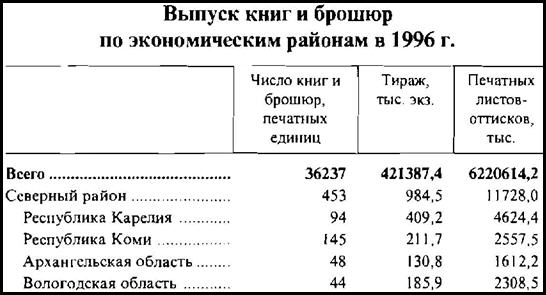

Obshchie bibliografii russkikh periodicheskikh izdanii, 1703-1954, i materially po statistike russkoi periodicheskoi pechati: annotirovannyi ukazatel.
Mashkova, M. B. and M. B. Sokurova, 1956, 139 p.
U of I Library Call Number: International & Area Studies Russian Reference (Slavic) and Oak Street Facility 016.057 L54O
Obshchie bibliografii russkikh periodicheskikh izdanii, 1703-1954, i materially po statistike russkoi periodicheskoi pechati: annotirovannyi ukazatel contains general bibliographies of Russian periodicals from 1703 to 1954 and statistical materials of the Russian press. At the end of the bibliography, there is a section entitled Spisok Materialov po statistike periodicheskoi pechati. Entries include author, name of publication, name of article, date, and issue number. If one is interested in statistical publications, they must peruse this list.


Statisticheskii ezhegodnik Rossii.
Saint Petersbug. Tsentralnyi statisticheskii komitet, 1904-1916 (1905-1918) god 1-13.
U of I Library Call Number: Slavic Reference MFICHE 314.7 R9212STE; Oak Street Facility 314.7 r9212ste vols. 5 and 10
HathiTrust full-text link for 1914: http://hdl.handle.net/2027/njp.32101067480986
Statisticheskii ezhegodnik Rossii is a general statistical yearbook with a main section titled Svdniia o gorodskikh poseleniiakh and a sub-section titled Biblioteki, chitalni, and periodicheskiia izdaniia (starting in year 10). It is difficult to find pre-revolutionary statistics regarding libraries, so this source is worth reading. Statistics are broken down by regions and then the following: the number of towns that have only libraries; the number of towns that have only reading rooms; the number of towns that have both libraries and reading rooms; and the number of towns that publish journals and newspapers.

Knizhnoe dielo v Rossii: po statisticheskim dannym “Knizhnoi lietopisi”
Russia. Glavnoe upravlenie po dielam pechati, 1914, 22 p.
U of I Library Call Number: History, Philosophy, & Newspaper Film 655.447 R92K
Information in Knizhnoe dielo v Rossii: po statisticheskim dannym “Knizhnoi lietopisi” is based on statistical data from the bibliographic journal Knizhnaia Letopis edited by A. D. Toropov. He was not only the editor of Knizhnaia Letopis but also the head of the units that compiled statistical data and also the one responsible for organizing yearly exhibitions. With the start of Knizhnaia Letopis in 1907, statistical data of all published material became available. This is a very interesting source for those interested in statistics on the book industry in pre-revolutionary Russia.
Statistical data on the development of printing matters in Russia were compiled by Glavnoe upravlenie based on the system adopted by Knizhnaia Letopis as of 1908, the first full publication year of Knizhnaia Letopis. Some of the charts included represent the following: books in Russian and other languages, and the number of languages in 1910; worth of all books by city for 1912, 1911, and 1910; the growth of periodical publication after 1905; and the number of registered periodicals given for 1908-1912, showing an increase of 37%; and newspapers published in a given language and city. Knizhnoe dielo v Rossii: po statisticheskim dannym “Knizhnoi lietopisi” also includes a diagram of the growth of the book business from 1885 to 1913. Within that one generation, the output grew four hundred percent.
The next part of Knizhnoe dielo v Rossii: po statisticheskim dannym “Knizhnoi lietopisi” includes information about the year 1913. Charts and diagrams include information about the distribution of books according to their contents, city, and language and information about the distribution of periodical publications according to time of appearance, language, subject, and city. There is also a chart on the condition of book exhibitions in 1913.
At the end of Knizhnoe dielo v Rossii: po statisticheskim dannym “Knizhnoi lietopisi,” there is also information about the exhibitions produced by Glavnoe Upravlenie. From 1909 until 1914, there were exhibitions of all printed materials printed in a given year in the spring months of every year. Examples and pictures are included.

Pechat SSSR za Sorok Let, 1917-1957: statisticheskie materially.
Vvedenskaia, A. V., and Masanov Iu., 1957, 143 p.
U of I Library Call Number: Main Stacks 655.447 V96pe
Pechat SSSR za Sorok Let, 1917-1957: statisticheskie materially begins with a section entitled “Razvitie Sovetskoi pechati za sorok let” that describes the development of Soviet print for forty years. In the chapter, time periods are divided as follows: Sovetskaia pechat v 1918-1945 gg. (further separation into 1918-1927, 1928-1937,1938-1940, 1941-1945); and Sovetskaia pechat v 1946-1956 gg. The latter section is divided by literatura type and then zhurnaly i drugie prodolzhaiushchiesia izdaniia and gazeta.
The majority of Pechat SSSR za Sorok Let, 1917-1957: statisticheskie materially consists of statistical charts divided into sections entitled Knigi, Zhurnaly/periodicheskie sborniki/biulleteni, Gazety, and Pechatnaia grafika/noty/karty. There are over fifty statistical charts and pictures. Statistical charts can be very general in nature such as “Vypusk knig i periiodicheskikh izdanii v SSSR za otdelnye gody” and ‘Vypusk knig i periodicheskikh izdanii v SSSR na iazykakh narodov Sovetskogo Soiuza i zarubeahnykh stran za 1913, 1940, and 1956 gody.” Statistics are also broken down in great detail by subject such as selskoe khoziaistvo, kultura, and estestvennye nauki, language, republic, and time periods.
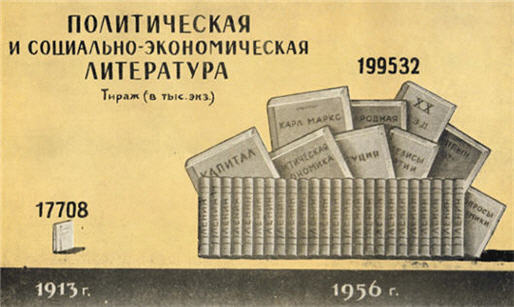

Knizhnaia statistika sovetskoi Rossii 1918-1923.
Isanitskii, Nikolai Fedorovich, 1924, 38 pages plus diagrammy.
OCLC: 38793466
Material was taken from Knizhnaia Letopis for the years 1918 to 1923. Publications in the journal reflected those of the Russian republic and not the entirety of the Soviet Union. Publications from the Ukraine, Belorussia, and beyond the Caucasus were poorly reflected. Knizhnaia Letopis was not comprehensive as all book deposited in Knizhnaia Palata were not indexed in Knizhnaia Letopis. 1923 was an especially bad year. For example, out of the 20,141 books deposited in Knizhnaia Palata only 13,380 made it into Knizhnaia Letopis. Only non-periodical publications except for music sheets were counted. Books were defined as anything over two pages.
In the first part of Knizhnaia statistika sovetskoi Rossii 1918-1923, there are many statistical charts (data is given by year or city or both). Examples of some are Obshchaia svodka kolilchestva knig, Raspredelenie knig po mesty izdaniia (1918-1923), Paspredelenie knig po izdatelstvam, Srednii tirazh (chislo ekzempliarov), and Raspredelenie knig po mestu izdaniia v zavisimosti ot grupp listov nabora. The second part consists of diagrams displaying the statistics.
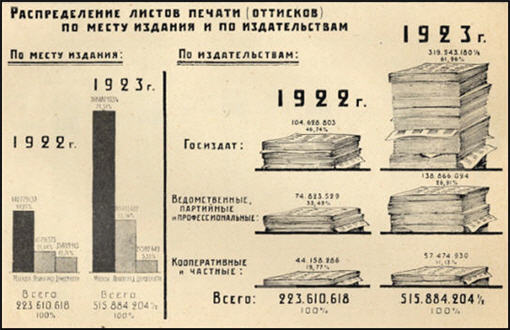

Pechat SSSR 1917-1954: statisticheskie materialy
Moskva. Izd-vo Vsesoiuznoi knizhnoi palaty, 1955, 86 p.
OCLC: 23165078
This sbornik reflects the state of the publishing industry from 1917-1954. There are four sections: obshchie dannye po knizhnoi produktsii; knigi na iazykakh narodov SSSR; nauka i narodnoe khoziaistvo; khudozhestvennaia literatura; and zhurnaly. In addition to statistics representing material printed in Russia, statistics also regard an enormous amount published in languages and cultures of various Soviet republics. According to the preface, material was published in 122 languages, out of which 40 had only first been put into writing after the Great October Revolution.
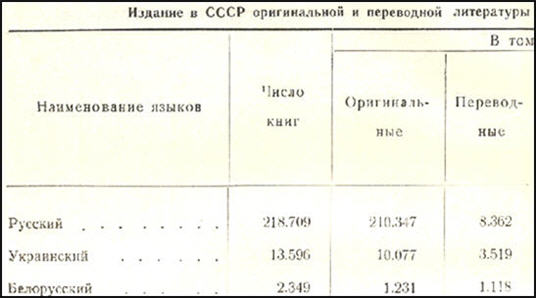

Russkaia Knizhnaia Statistika: iz istorii vozniknoveniia i razvitiia.
Zdobnov, Nikolai Vasilevich, 1959, 53 p.
U of I Library Call Number: Main Stacks 655.447 Z19R
Some chapters of Russkaia Knizhnaia Statistika: iz istorii vozniknoveniia i razvitiia were published earlier during the life of the author in the periodicals Bibliograficheskikh izvestiiakh (1927), Khoziaistve pechati (1930), and Sovetskoi bibliografii (1934), but most of them were not published until this work. Russkaia Knizhnaia Statistika: iz istorii vozniknoveniia i razvitiia is divided into three sections: russkaia knizhnaia statistika do revoliutsii (1810-1916); Sovetskaia knizhnaia statistika (1918-1930); and o nekotorykh teoreticheskikh voprosakh knizhnoi statistiki. There is also a supplement entitled Osnovnye elementy statisticheskogo nabliudeniia (1801-1926).
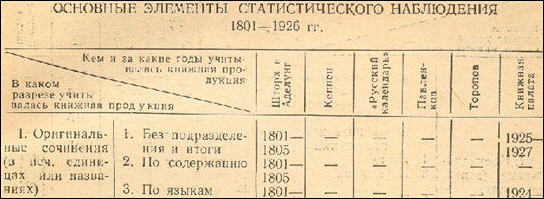

Pechat SSSR za 50 let: statisticheskie ocherki.
Sostavitel P. A. Chuvikov, 1967, 197 p.
U of I Library Call Number: Main Stacks 655.447 P333
Pechat SSSR za 50 let: statisticheskie ocherki presents statistical data on books and brochures, periodical and continuing publications, newspapers, and printed graphics and music from 1913 and 1918 to 1966.
Books and brochures:
This section contains statistical data for books and brochures published in the Soviet Union for the years 1913 and 1918-1966. It also contains statistical data about books and brochures published in individual republics, first those in the Russian language and then those in the native language of that republic. Books and brochures published in foreign languages such as English, German, Polish, and French are also included. Data are also divided by topics such as Estestvennye nauki, Matematika; Pechat. Knigovedenie. Bibliotechnoe delo. Bibliografiia; Spravochniki obshchego kharaktera; Iskusstvo; Gosudarstvo i pravo; and Istoriia, etc. Topics such as Estestvennye Nauki are further broken down into Matematika, Geologiia, Geografiia, Biologiia, etc.
Periodicals and continuing publications:
This section contains information about journals and other periodicals and continuing publications in the languages of the people of the former Soviet Union and in foreign languages for the years 1940, 1946, 1960, and 1966. Statistical data is presented in general terms by na russkom iazyke, na iazykakh narodov SSSR, and na iazykakh narodov zarubezhnykh stran and in more specific terms by individual republics. This section also contains information about journals and other periodicals and continuing publications according to type such as journals, sborniki, biulleteni, and bloknoty agitatora for the years 1940, 1946, 1960 and 1966.
Newspapers:
This section contains information about newspapers in the languages of the people of the former Soviet Union and in foreign languages for the years 1940, 1946, 1960, and 1966. Statistical data is presented in general terms by na russkom iazyke, na iazykakh narodov SSSR, and na iazykakh narodov zarubezhnykh stran and in more specific terms by individual republics. Data is also presented by type such as vsesoiuznye, respublikanskie, kraevye (oblastnye i okruzhnye), gorodskie, etc. It also contains statistical data about newspapers published in individual republics, first those in the Russian language and then those in the native language of that republic.
Pechatnaia Grafika, noty :
This section contains statistical data about pechatnoi grafiki for the years 1934-1966. The first tablitsa contains data about pecatnoi grafiki such as plakaty, reproduktsii, and otkrytki. The second tablitsa contains data about music such as muzykalnye proizvedeniia, sobraniia sochinenii, and uchebnaia literature.
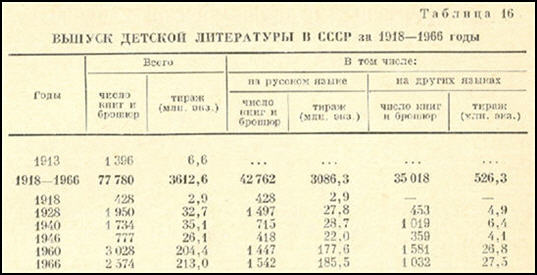

Websites
Rossiiskoe Obrazovanie Federalnyi Portal

Rossiiskoe Obrazovanie Federalnyi Portal is a portal to universities, academies and institutes in the Russian Federation. Here you can find which universities offer which disciplines.
One can search by institution, city, specialty, code, or a combination. Searching by specialty or code retrieves all the institutions in the Russian Federation that offer that particular degree. In the search interface, there is a field entited “Vybrat spetsialnost” and a link “OKSO.” The link leads to a list of disciplines, specialties, and their codes entitled “Perechen: napravlenii podgotovki (spetsialnostei) vysshego professionalnogo obrazovaniia.” Subjects are arranged by general disciplines and then further divided by specialty. Each specialty is given a code. Examples are as follows: gumanitarnye i sotsialnye nauki then specialties knizhnoe delo (030900)and izdatelskoe delo i redaktirovanie (030901); kultura i iskusstvo then specialties bibliotechnoe-informatsionnye resurcy (071200), bibliotechnoe-informatsionnaia deiatelnost (071201), and muzeinoe delo i okhrana pamiatnikov (070503); and ekonomika i upravlenie then specialty statistika (080600 and 080601). Within the specialties, there are codes for bakalavr (bachelor), magistr (master’s), etc. It is a good idea to check this list for the controlled search terms of disciplines.
You can also limit a search by forma obucheniia (liubaia, ochnaia, ochno-zaochnaia, zaochnaia, and eksterant), vid (liuboi, universitet, akademiia, and instityt), and organizationno-pravovaia forma (liubaia, gosudarstvennyi vuz, and negosudarstvennyi vuz).
